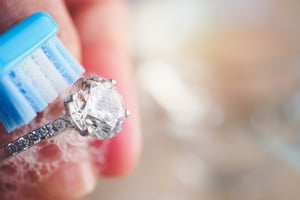Whether you’re newly engaged, celebrating a
milestone anniversary, or  the recipient of a Valentine’s day gift, insuring and caring for your jewelry is important.
the recipient of a Valentine’s day gift, insuring and caring for your jewelry is important.
While jewelry is created to bring enjoyment and happiness for a lifetime, it’s no different than our other possessions. Everyday wear and tear can cause damage to it, especially if you wear your jewelry all the time.
Most homeowners policies carry coverage limitations on personal property, such as jewelry. If your jewelry is valuable, it’s best to schedule it, or have it specifically itemized with a value on your policy.
Here are some tips to ensure your jewelry brings you lifelong joy and happiness.
Tips for protecting your jewelry from damage
1. Don’t expose your jewelry to chlorine or saltwater. Always remove your jewelry when you’re on vacation or enjoying your hot tub or swimming pool. Chlorine, salt, and other minerals can react with the metal alloys causing damage.
2. Never put jewelry in your pocket. While the intention of preventing damage to or loss of your jewelry is good, the outcome may be bad. If you’re traveling, pick pocketers are smooth criminals and may steal it without your knowledge. Or you may never remember what pocket you put it in. It’s best to store your jewelry in a safe place and one that you’ll remember.
3. Remove your jewelry before exercising. Depending on the jewelry type, sweat can cause it to look worn out or possibly cause it to corrode. Also, unintentionally banging your jewelry on exercise machines and weights can cause scratches or bends.
4. Remove your jewelry before carrying out household chores. Many cleaning products contain chemicals that can react with jewelry, causing damage. Avoid wearing your rings with rubber or latex gloves. Due to the extremely tight fit, prongs on a ring could be damaged, causing your stone to fall out. Outdoor activities that involve maintaining your property can cause your jewelry to encounter abrasive items such as dirt, rocks, or concrete.
5. Don’t apply lotion, makeup, or other products. These products should always be applied before putting on your jewelry. These products can damage pearls and other fragile gemstones.
7. Don’t remove jewelry in the kitchen or bathroom. A simple bump and your jewelry could be going down the drain.
8. Visit your jeweler regularly. Not only will your jeweler give your jewelry a good cleaning, but they’ll also be able to inspect it for damage and fix it before it worsens.
Tips for cleaning your jewelry
Many different home cleaning remedies are available depending on the type of jewelry. Here are just a few remedies that may work for you.
| Jewelry Type | Remedy |
| Sterling Silver | Soaking your silver jewelry is an excellent way to remove tarnish. Everyday household items you’ll need include baking soda, hot water, and a bowl lined with aluminum foil. |
| Gold | Soaking your gold jewelry in a gentle solution of dish soap and warm water is an easy way to bring the shine back. A soft toothbrush will do the trick to clean between crevices or prongs. |
| Diamonds | The same mixture to clean gold jewelry can be used for your diamonds. To make your diamonds shine, consider using an ammonia-based cleaner. |
| Gemstones | A gentle solution of dish soap and warm water along with a soft toothbrush will work well. |
| Pearls | Due to the way pearls are formed, they require special care. Pearls should be gently wiped after each wearing. Visiting your jeweler yearly is your best option for maintaining their beauty and integrity. |
| Fashion Jewelry |
Consider using toothpaste to bring the bling back. |
Tips for insuring your jewelry
Call your agent to determine if your policy provides coverage or has high enough limits. A basic homeowners policy only covers damage to personal property due to the following perils.
| Fire or lightning | Windstorm or hail |
| Explosion | Riot or civil commotion |
| Damage caused by aircraft |
Damage caused by vehicles |
| Smoke | Vandalism or malicious mischief |
| Theft | Volcanic eruption |
If your jewelry accidentally goes down the drain and you have a basic policy, there will be no coverage.
You may be able to schedule jewelry items at a nominal premium charge with no deductible. You may also have the choice of scheduling your jewelry on a replacement cost or an agreed value basis.
If you have replacement cost coverage, your insurance company may pay the cost to repair or replace the damaged or lost property without factoring in depreciation. Please note that the amount paid won’t exceed the least of these amounts.
- Replacement cost at the time of the loss
- The total cost to repair at the time of the loss
- The amount of insurance that applies to the property as shown on the declarations page of your policy
If you have agreed value coverage, each item scheduled on your policy is given a reimbursement amount. If you have a loss, that agreed amount will be paid to you.
If you have jewelry in your family that has been passed down to you, make sure you get it appraised. An appraisal will provide precise details about it. This will help you select the necessary insurance coverage you need.
Do you have any suggestions or information you’d like to share? I’d love to hear from you. Please share them in the box below.
Source:
https://rogersandhollands.com/caring-for-your-jewelry
https://www.goodhousekeeping.com/home/cleaning/tips/a25736/how-to-clean-jewelry/
https://www.iii.org/article/which-disasters-are-covered-by-homeowners-insurance
This article is intended for general educational and illustrative purposes only and should not be construed to communicate legal or professional advice. Further, this article is not an offer to sell insurance. Please consult with your licensed insurance agent for specific coverage details and your insurance eligibility. All policies are subject to the terms, conditions, limitations, definitions, and exclusions contained therein.





